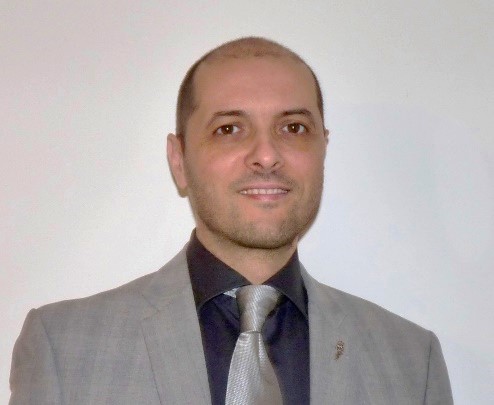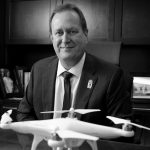On-Demand IoT WebTalk: Utilising Mobile Connectivity for Drones Remote Identification
On this IoT WebTalk, aviation and mobile industry experts from the Federal Aviation Administration (FAA), the European Aviation Safety Agency (EASA), Skyward, A Verizon company and Vodafone discuss the importance of remote identification (Remote ID) for drones, the current regulations and plans, and how mobile network operators are leveraging mobile connectivity and delivering on these regulations to achieve identification in the drones ecosystem.
- Full Presentation
Moderated by Barbara Pareglio, Director for Aviation and Drones, GSMA IoT - Introduction to Remote ID: The Principles, Current Regulations and Future Plans in the USA
Jay Merkle, Executive Director, Unmanned Aircraft Systems (UAS) Integration Office, Federal Aviation Administration (FAA) - European Regulations on Remote ID and Future Plans
Natale Di Rubbo, Drone Project Manager, European Aviation Safety Agency (EASA) - Mobile Connectivity for Drones remote identification: Skyward’s initiatives in the US
Eric T. Ringer, Co-founder and Director of Aviation Technology, Skyward, A Verizon company - Mobile Connectivity for Drones remote identification: Vodafone’s initiatives in Europe
Dr Eric Murray, Principal Engineer, Vodafone Group Technology - Panel Discussion (See Q&A content below)
Skyward would also like to share a free e-Book on The Near Future of Connected Drones: Strategic Planning for Enterprises
Speakers

Natale Di Rubbo
Drone project manager, European Aviation Safety Agency (EASA)
Since 2016 Natale Di Rubbo has been the rulemakings officer for drone regulations and has coordinated the team in charge of developing the proposal for the new European drone regulation.
From early 2020 he has been the EASA project manager for all activities related to drone operations in the open and specific category.
Before joining the EASA, Natale was employed as an Air force officer at the Italian Military Airworthiness Authority, and had the role of project certification manager for several manned and unmanned military aircraft.
Natale graduated as Electronic engineering at the University Federico II of Naples and attended a Master in International Relations and Affairs at the University of Roma Tre.

Jay Merkle
Executive Director, Unmanned Aircraft Systems Integration Office, Federal Aviation Administration (FAA)
Prior to being named the new Executive Director of the Unmanned Aircraft Systems Integration Office, Peter “Jay” Merkle was the Deputy Vice President (DVP) of the Program Management Organization (PMO) within the Air Traffic Organization (ATO). The PMO is responsible for all NextGen program activity; all National Airspace System (NAS) communications; navigation, weather, surveillance and automation modernization programs; and all service life extensions to legacy NAS sensors, communications and navigation aids. Given the tight coupling between successful automation program delivery and current system operation, the PMO also leads and manages all second-level automation engineering efforts. Lastly, the PMO works with FAA operations and aviation users to ensure globally interoperable solutions for NextGen.
Prior to that position, Merkle was the Director of Program Control and Integration, AJM-1, in the PMO for the ATO. In that capacity, he led the PMO in developing effective, timely, and innovative solutions to evolving business needs. The focus areas were program control, cross-cutting analysis and integration, and special initiatives.
Since joining the FAA, Merkle has served as the Manager of Systems Integration for Portfolio Management and Technology Development within the NextGen organization. He also has held positions as the Lead Engineer for tower, terminal, and en route automation systems, as the Chief System Engineer for En Route and Terminal Domains, and as the Chief Architect for NextGen at the Joint Planning and Development Office.
Merkle has over 30 years of extensive experience in engineering and program management. He started his career as an engineer working in cockpit and crew station design on several aircraft, including the C-17 large transport aircraft. Merkle holds a Bachelor’s degree in Psychology from the University of Central Florida and a Master’s degree in Industrial Engineering and Operations Research from the Virginia Polytechnic Institute and State University.

Eric T. Ringer
Chief of Staff, Robotics Business Technology, Verizon
Eric T. Ringer is co-founder and Director of Aviation Technology at Skyward, a Verizon company.
In his role as Director of Aviation Technology he leads the product and engineering teams developing 4G LTE & 5G products for aviation.
Prior to Skyward, Eric was a systems engineer at contractors for both NASA and Sikorsky.

Dr Eric Murray
Principal Engineer, Vodafone Group Technology Networks Architecture
Dr Murray is Principal Engineer within Vodafone Group Technology Networks Architecture, where he has worked since 2014. He is responsible for identifying and developing new technologies and innovations of interest to the Vodafone Group of companies, and evaluating them in proof of concept trials.
As part of a small team, Dr Murray was responsible for developing the original “Flying CrowdCell” demonstrated at MWC’17, and later for trials demonstrating the benefits of cellular connectivity for drones, including the Radio Positioning System – Vodafone’s network-based drone tracking technology.
More recently, Dr Murray was responsible for testing the Wavelength MEC (Mobile Edge Computing) offering from AWS as part of their collaboration with Vodafone. His current role is to develop standardised APIs to support novel use cases for Vodafone’s networks, such as drone authentication.

Barbara Pareglio
Senior Technical Director, Smart Mobility Lead, GSMA
Since 2014, she has been the technical lead for several areas of focus within the GSMA such as 5G, IoT, automotive, aviation and more. Looking at how to best utilise new technologies and services from the constantly evolving mobile networks, like 5G-Advanced.
Barbara is also leading several activities and communities with the GSMA members, like the activities related to smart mobility, including automotive and advanced air mobility. The latter by leading the GSMA Drone Interest Group and the Aerial Connectivity Joint Activity, to investigate and help the mobile industry to create a trusted solution for commercial unmanned aircraft. Exploring features and capabilities of 4G and 5G needed for the aviation.
Barbara has over 20 years of experience in the mobile industry. Before joining the GSMA, Barbara worked in R&D in several areas of telecommunications. She also participates and actively contributed to, several standards.
Q&A
Natale Di Rubbo, EASA: The EU Regulation 2019/945 includes an add-on remote identification that can be retro-fitted to the legacy drones.
Natale Di Rubbo, EASA: In general drones are required to be equipped with a remote identification system, however EU Member States may identify geographical zones where remote identification is not mandatory.
Jay Merkle, FAA: Cellular networks cover more than 98% of the populated areas of the United States. Their existing infrastructure will help to enable command and control and remote ID functions for VLOS and BVLOS operations in areas most likely to be serviced by UAS. Due to their ability to handle a large user base, cellular networks may be an ideal candidate for scalable multi-aircraft operations across the national airspace system.
Jay Merkle, FAA: Remote identification is already an inherent capability in mobile connectivity. Cellular networks use a number of methods to track and identify mobile users. By leveraging SIM card technology and identification protocols, UAS may also leverage this capability.
Jay Merkle, FAA: Performance-based testing is the key to understanding the capabilities and limitations of the cellular network to support UAS operations. It is important for the mobile industry to inform the government of the limitations of these systems to support airborne users as well as the interference basis to terrestrial users. The FAA and FCC are key players in the regulatory process and will benefit greatly from operational test data captured by the service providers.
Jay Merkle, FAA: The Remote ID NPRM proposed that UAS would transmit remote identification messages through the internet to a Remote ID USS at a rate of at least once per second. At this stage, any recommendations by MNOs should have been submitted during the comment period. We are currently working to finalize the rule based on the comments we’ve received. However, we cannot comment on the content of the final rule.
self separation, DAA, collision avoidance, etc. What is FAA position on relationship between UAS RID & safety uses?” background=”yes” colour=”blue”]
Jay Merkle, FAA: RID will give the same type of information as cooperative surveillance produces. The positions of the aircraft in the airspace at a particular time. RID will enable the broad set of tools to analyze the actual behavior and safety risks in the airspace. For Example, we will be able to correlate pilot reports of UAS in near real time with the UAS in the area to determine if a safety risk was present, or even if there was a UAS In the area at all.” While ASTM did not develop their RID Standard to address traffic management, the inherent capabilities in the system that are required for RID can be used to support a traffic management system.
All speakers: Answered in panel discussion from 52min 10sec to 56min 40sec.
Dr Eric Murray, Vodafone: Our knowledge of the drone identity is based on the SIM, so if the SIM used in the prepaid phone is not registered as a drone SIM with us, then we could not provide an identifier to the U-space. It is always up to U-space to decide how to manage a drone. In this case, we would be saying to U-space that we do not have any additional knowledge of who is operating the drone, or even that it is a drone. However, the drone could still communicate with U-space to confirm its identity, but this would be transparent to our network.
Dr Eric Murray, Vodafone: Not at all. Most drones would not need to support N-RID, and there would be nothing to stop a drone that did need to support this to use, say, a satellite link instead of cellular. So cellular is just one option. Using the Vodafone network would provide additional advantages to both drone and U-space operators as described in the presentation, but all standards and protocols used will be open and can be implemented by other cellular networks.
Dr Eric Murray, Vodafone: Geographical coverage from 4G is already very high in most Western European countries at ground level, and is usually even better at height as there are less obstacles between the cell site and the drone. So if a drone has coverage at ground level, it will very likely have coverage for a reasonable BVLOS mission around that location. Whether the throughput available is sufficient for the drone depends on the nature of the mission.
Eric T. Ringer: There is a lot of service we can provide to drones on 4G LTE. We’ll see the greatest benefits to drones from 5G for applications where traits of 5G shine. That includes applications like high definition video streaming taking advantage of mmWave spectrum. As the number of connected drones increases, 5G’s ability to handle a high density of connections is another way 5G could be beneficial.
Natale Di Rubbo, EASA: Network remote-identification in support of U-space will be firstly deployed in the area where higher traffic is expected that in general should be urban areas where, depending on the final technology that will be chosen, the network coverage may not be an issue. Then gradually it is expected that the area covered by U-Space may expand, however this will be possible only in the area where an adequate network coverage is ensured.
Jay Merkle, FAA: There are many areas in the US where network coverage is not available. For this reason the FAA included a broadcast mode of RID to augment network coverage.
Natale Di Rubbo, EASA: (In Europe) Remote identification system will not be linked to the type of the operation but to the area where the drone operates. For example in the areas where the U-space will be deployed, all drones will be required to have a network identification system. Therefore for the purpose of remote identification, there is no difference between a drone, a cargo or a UAM carrying passengers.
Jay Merkle, FAA: (In the US) We expect that the initial UAM will participate in Air Traffic Management (ATM) rather than UTM. Both Advanced Air Mobillity (AAM) and Upper E occur in airspace where Air Traffic Control (ATC) provides separation services so the structure, performance, and information will of necessity be different and so they are not just like UTM. Participation in the UTM is voluntary and the first AAM operations will occur within the ATC system for separation. The expected tempo or the limitations of remote/autonomous operations will make many choose the AAM (including UAM) and Upper E flight rules and technology to support their business cases.
Natale Di Rubbo, EASA: The U-space approach that is now proposed for EU regulation introduces the first building blocks to ensure, in the future, a more integrated system where unmanned aircraft and manned aircraft can safely fly in the U-space. So indeed, safe integration with ATM is the end objective of the work done on U-space at EU level.
Jay Merkle, FAA: When we talk about UTM, AAM and Upper E we consider the vehicle, the manner in which it is operated and the airspace in which it will operate. The Airspace includes the interaction between the vehicles participating in the flight rules as well as with other aircraft. The basic premises of UTM will extend to advanced AAM and to Upper E. Those principles are that there will be digital interaction via, at a minimum, a network to support operations of participating aircraft and that there will be cooperative separation between the operators to support the flight rules. UTM is clearly leading the way in terms of this federated information exchange model and the establishment of rules. All will be based on a federated public-private partnership with FAA-approved community-based rules tailored to the characteristics of each environment. Both AAM and Upper E occur in airspace where ATC provides separation services so the structure, performance, and information will of necessity be different and so they are not just like UTM. Participation in the UTM is voluntary and in fact in Upper E today and the first AAM operations will occur within the ATC system for separation. The expected tempo or the limitations of remote/autonomous operations will make many choose the AAM (including UAM) and Upper E flight rules and technology to support their business cases.
Dr Eric Murray, Vodafone: The network receives telemetry from the cellular modem that tells the network how strongly it can hear neighbouring cell sites. This information can be used together with knowledge of the network configuration to estimate the location of the device (in this case, the drone). It will not be as accurate as GPS, but it does not need to be. Rather, it is an independent estimate of the drone’s location that can be used to verify that the drone is not spoofing its location.
Dr Eric Murray, Vodafone: Our knowledge of the drone identity is based on the SIM. If the SIM used in the prepaid phone was not registered as a drone SIM with us, then we could not provide an identifier to the U-space. However, the drone could still communicate with U-space and could signal its identity (transparently to our network) using N-RID. In this case, we would be saying to U-space that we do not have any additional knowledge of who is operating the drone, or even that it is a drone. It is always up to U-space to decide how to manage a drone.
Dr Eric Murray, Vodafone: If the SIM is removable, then we can’t generally prevent this, and may not want to anyway if we are providing a set of SIMs to a fleet operator. It is possible to lock a SIM to a device (identified by IMEI) but I don’t think that is necessary. Remember that drone identity is primarily established by encrypted communications between the drone and U-space, which is transparent to our network. The identity we provide to U-space is only intended to verify this and, in this case, may or may not match the identity signalled by the drone itself, dependent on whether we identify only the operator (who may operate multiple drones and have just moved SIMs between them) or the drone itself. If two different drone operators swap SIMs, then the identity we signal would not match that signalled by the drone. If the identity we provide to U-space does not match that signalled directly by the drone, it is up to U-space to decide how to manage that drone.
Dr Eric Murray, Vodafone: For the foreseeable future, something that implements SIM functionality in the modem will be required, even for cellular IoT use cases and even if that functionality is implemented purely in software. As far as the network is concerned, if it behaves like a SIM, it is a SIM, and the proposed scheme would work. Connectivity via a cellular network requires secure authentication, and we are proposing that this internal identifier be used to verify the identity signalled by the drone to U-space. These do not need to be the same identifier, but must be cross-referencable.
GSMA: For more information on eSIM, please visit: https://www.gsma.com/esim/
Dr Eric Murray, Vodafone: Currently, our 4G and 5G networks are only used for IP data transport, so any client/server scheme based on IP will work over a cellular network. It’s just encrypted data to us. But for a device to be able to use the cellular network, we must first securely establish its identity for ourselves, and this enables us to provide a “second opinion” as to the identity of the device (to trusted external systems). This is the scheme that is being proposed.
GSMA: For more information on eSIM, please visit: https://www.gsma.com/esim/
Dr Eric Murray, Vodafone: The accuracy is dependent on the cell site density, so varies from maybe 50 metres in urban areas to a few hundred metres in rural areas. This is accurate enough to verify that the drone is not significantly spoofing its GPS location to U-space. U-space would make this decision, as we do not see the GPS location signalled by the drone.
Dr Eric Murray, Vodafone: Yes, that was described in the presentation. N-RID authentication mechanism is just encrypted data to our network, so is between the drone and the U-space. But we can provide additional verification of the drone identity and location to U-space if it wants to be sure it is not being spoofed. We can also provide an indication of the cellular coverage that a drone might experience in a given area to aid mission planning.
Dr Eric Murray, Vodafone: In Europe, 5G deployments do not yet use mmWave as the spectrum is not available. For sub-6 GHz spectrum, there is not much difference between 4G and 5G as far as interference is concerned in these bands. So whatever interference mitigation techniques we use for 4G would also be applicable to 5G.
Dr Eric Murray, Vodafone: Only one cellular modem / SIM is required per drone, but how that modem interfaces with other systems depends upon these systems. The only requirement is that IP is used for data transport by the on-board system. For our own trials, we typically interface a Raspberry Pi microcomputer to the modem, and use one of the many interface options offered by the RPi to connect to the other on-board systems, such as the flight controller or camera.
Dr Eric Murray, Vodafone: In Western Europe, it is pretty unlikely that a drone would have a good signal from one operator and a poor signal from another. It is more of an issue at ground level, but differences in network topology and the effects of terrain shadowing are less significant for a drone flying above most terrain features. However, even if we wanted to allow drones to connect to different networks, national roaming (roaming onto other networks in the same country as the SIMs home network) is not allowed by most European regulators. So regulation would also need to change.
Dr Eric Murray, Vodafone: As described in the presentation, authentication between client (i.e. drone) and server (i.e. U-space) is just encrypted data to us. So we don’t really care what scheme is used. What we can provide is a “second opinion” on the identity of the device (i.e. drone), and the U-space can use this to verify the identity signalled by the drone as it chooses. Of course, if the primary mechanism to establish identity is “guaranteed”, then U-space may feel it does not require such verification. But history is full of many “secure” schemes that turned out not to be so secure after all. The advantage of 2 Factor Authentication (2FA) is that two schemes need to be compromised, not just one.
Dr Eric Murray, Vodafone: As described in the presentation, authentication between client (i.e. drone) and server (i.e. U-space) is just encrypted data to us. So we don’t really care what scheme is used as we’d expect this to be E2E encrypted. What we can provide is a “second opinion” on the identity of the device (i.e. drone), and the U-space can use this to verify the identity signalled by the drone as it chooses. If APIs become an established way of achieving this, then we would work to standardise this through, for example 3GPP.
Dr Eric Murray, Vodafone: First point to note is that the protocol that the drone uses to establish its identity to the U-space is transparent to our network – we just see encrypted data and don’t really care what they are saying to each other. The second point to note is that our networks are designed so that the IP address allocated by us to a device ensures that that device is anonymous – a server cannot identify a device just from its public IP address and that will always be the case. However, what we can offer is to provide a second identifier to trusted systems (such as U-space) that allows it to verify whatever identity was signalled transparently to us, and that was the scheme described in the presentation.
Dr Eric Murray, Vodafone: There is still much uncertainty around when and in what form U-space / UTM systems will start to be deployed. So we are still primarily working on demonstrating capability to regulators and the drone industry using what are essentially proprietary protocols. We don’t see it as our place to drive development of such standards – this would take considerable resources on our part and we are aware that much of the UTM functionality could be achieved just using the cellular network as a secure bit pipe. This would be just a tiny part of the overall market, and would not get much attention from us. If regulators and the drone industry in general are interested in our ideas, then we would be open to working towards standardised solutions, perhaps through 3GPP or the TMForum.